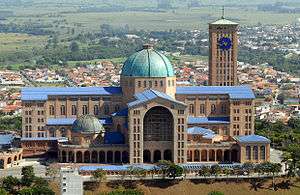Religion in South America
Religion in South America is characterized as a continent where the majority of the population professes the Catholic faith, with a notable increase of Protestants and people without religion.
Religious freedom
Currently, all countries in the region in general are separate of the Catholic Church and declared laic states, which guarantees freedom of religion for its inhabitants. The last country to approve the freedom of religion was Bolivia (since 2008).
Christianity

According to the Association of Religion Data Archives 91.9% of the South American population is Christian,[2] although less than half of them are praticant.
Catholicism
Except for Suriname and Uruguay, the more professed religion in the South American countries is the Catholic religion. While countries such as Paraguay, Peru, Colombia and Argentina more than three quarters of the population is Catholic, in Chile is 57%.
Catholicism was the only religion allowed in the colonial era, the indigenous were forced to abandon their beliefs, although many did not abandon it at all, for example, countries with predominantly Amerindian population such as Bolivia and Peru there is a syncretism between indigenous religions and the Catholic religion, that has occurred since colonial times. In Brasil or Colombia, Catholicism was mixed with certain African rituals.
Protestantism
Protestantism has been around since the nineteenth century, as a minority, but has had a strong increase since the 1980s. The majority of Latin American Protestants in general are Pentecostals.[3] Brazil today is the most evangelical country in South America, where 89% of Brazilians evangelicals are Pentecostals, in Chile represents 79% of the total evangelicals in that country, 69% in Argentina and 59% in Colombia.[3] On the other part, in Uruguay 66% of evangelicals are Methodists, while only 20% are Pentecostal.[3]
Other Christian
Practitioners of The Church of Jesus Christ of Latter-day Saints and Jehovah's Witnesses religions also are exercised in Latin America.
Non-Christian Religions
Argentina hosts the largest communities of both Jews[4][5][6] and Muslims[7][8][9] in Latin America.
Brazil is the country with more practitioners in the world of Allan Kardec's Spiritism. Practitioners of the Judaism, Buddhist, Islamic, Hinduism, Bahá'í Faith, and Shinto denominations and religions also exercised in Latin America.[10]
Indigenous creeds and rituals are still practiced in countries with large percentages of Amerindians, such as Bolivia and Peru.
Statistics
Part of Religions in South America (2013):[11]
| Countries | Christians | Roman Catholics | Other Christians | Others, no religion (atheists and agnostics) and no answer |
|---|---|---|---|---|
| 84 % | 77 % | 7 % | 16 % | |
| 93 % | 76 % | 17 % | 7 % | |
| 84 % | 63 % | 21 % | 16 % | |
| 70 % | 57 % | 13 % | 30 % | |
| 78 % | 75 % | 3 % | 22 % | |
| 93 % | 81 % | 12 % | 7 % | |
| 96 % | 88 % | 8 % | 4 % | |
| 87 % | 77 % | 10 % | 13 % | |
| 49 % | 41 % | 8 % | 51 % | |
| 91 % | 79 % | 12 % | 9 % |
References
- ↑ Facts of Basilica of Aparecida
- ↑ Largest Religious Groups (South America). The Association of Religion Data Archives (ARDA)
- 1 2 3 «Luis Palau: Evangelist to Three Worlds», Christianity Today, 20 de mayo de 1983, pp. 30-1. Luis Palau, «The Gospel's Social Impact», Briefing (Portland, Oregon: Cruzada Luis Palau), verano de 1984, pp. 14-16.
- ↑ LeElef, Ner. "World Jewish Population". Retrieved 2008-01-09.
- ↑ The Jewish People Policy Planning Institute; Annual Assessment, 2007
- ↑ United Jewish Communities; Global Jewish Populations
- ↑ Bureau of Western Hemisphere Affairs - Background Note: Argentina
- ↑ International Religious Freedom Report 2008 - Argentina
- ↑ Árabes y musulmanes en América Latina
- ↑ LANIC religion page
- ↑ "Las religiones en tiempos del Papa Francisco" (PDF) (in Spanish). Latinobarómetro. April 2014. p. 7. Archived from the original (pdf) on 4 April 2015. Retrieved 4 April 2015.